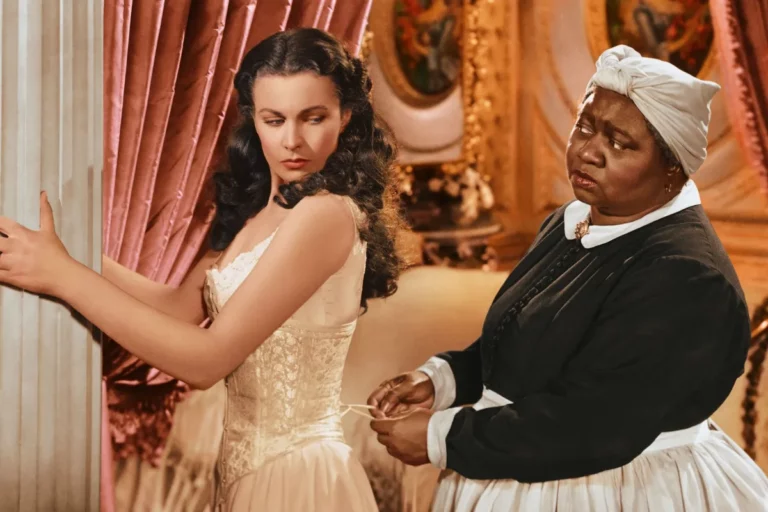
This article was a finalist in the 2022 DC Student Arts Journalism Competition. The article was first published in the magazine Salvation South. Click here to learn more about the competition.
“Gone With the Wind” and its red-earthed Georgia have been on my mind for some time. The backdrop of racial violence in Buffalo, January 6 insurrection hearings, and ongoing attacks on so-called antiracist indoctrination have all informed my new perspective on the 1936 novel.
I once loved “Gone With the Wind,” the tale of a spoiled Southern belle and the incineration of her antebellum utopia. I once caressed its cover depicting a couple dressed in white clutching each other against a burnt orange sky, the shade of battle. But when I opened my copy of the book recently, I paused at a line from Pat Conroy’s preface in the 2008 Pocket Books edition: “No black man or woman can read this book and be sorry that this particular wind has gone.” After reading that, I wondered what it meant to be a Black Southern writer and an heir to scorned earth during these tumultuous times. I know now that the novel’s world of division and delusion could never truly be gone.
By the eighth grade, I decided I wanted to be cultured. That desire led me to watch Golden Age Hollywood films and read what was considered the greatest literature of all time. Of course, the book and film versions of “Gone With the Wind” were a part of my cultivation. I do not remember my initial reaction to the romanticization of oppression in the sprawling novel. Surely, I must have resisted the comical and contemptible depiction of enslaved Black people. I must have winced at the transcription of Black vernacular and how it implied a Negro grin despite the horrors of chattel slavery. So, why do I only recall a kind of passive consumption—my eyes glued on the page, my mind unquestioning?
I could attribute my lack of critical engagement then to the ignominious education I received on enslavement. Most of my lessons on slavery involved my teachers relaying scattered facts about plantation life or screening an animated episode on abolitionist Harriet Tubman from the 1990s children’s television series “Animated Hero Classics.” According to the public schools I attended, slaves led palatable lives, their biographies rendered in cartoon colors.
The same year I read “Gone With the Wind,” my social studies teacher distributed notes for students to fill in and informed us that plantation owners treated enslaved Black people “relatively well.” He emphasized this point by screening a whipping scene from the 1977 miniseries “Roots” and claiming that plantation owners did not subject slaves to such violence. Later, my teacher led a principal-approved Underground Railroad activity in which me and my classmates roamed the halls as runaway slaves and asked other participating teachers if they were “friends or foes.” The goal was to garner three signatures guaranteeing our freedom.
The minimization of enslavement continues in public schools across the country. In June, the Texas Tribune reported that the Texas State Board of Education received a proposal from a group of educators seeking for slavery to be taught as “involuntary relocation” for second-grade social studies. This erasure of America’s racial history has accelerated with the enactment of legislation restricting how educators discuss racism and systemic inequality in classrooms. According to Education Week, 42 states have introduced bills or taken actions that restrict the teaching of critical race theory—an academic framework typically taught in graduate school— and regulate how teachers discuss racism.
When I was 15, in 2015, my father bought me a copy of “Gone With the Wind” for Christmas. Six months had passed since Dylann Roof, a white supremacist, murdered nine Black parishioners of Emanuel African Methodist Episcopal Church in Charleston. Somehow, I did not connect his Lost Cause ideology with that of the book. But like “Gone With the Wind,” which characterized enslaved Black people as grateful to their oppressors, Roof insisted on the benevolence of chattel slavery.
In an archived version of his nearly 2,500-word manifesto, Roof wrote that he read hundreds of slave narratives that were largely positive, with many of them purporting that slaveholders prohibited whippings on their plantations. Before he entered Mother Emanuel, Roof visited a Confederate museum and former plantations in South Carolina —remnants of the Old South so glorified in Margaret Mitchell’s novel.
And yet I still collected the book, missing these horrific parallels between past and present. Upstairs in the bonus room of my parents’ house, I placed the book in an empty display cabinet. It joined Harper Lee’s “To Kill a Mockingbird,” Sharon M. Draper’s “Tears of a Tiger” and other books that I favored. The titles were arranged unconventionally: flat down and placed in threes on top of one another instead of spine up and shelved sideways. I wanted them evenly placed according to weight and dimension. The taller books were on the bottom of each pile while the smaller, stouter books were on the top. In this unusual arrangement, my paperback version of “Gone With the Wind” wound up on top.
It was not until last year, after reading and collecting Ann Petry’s “The Narrows,” that I decided to remove “Gone With the Wind” from my book collection. Petry’s 1953 novel is set in Connecticut and focuses on an affair between Link Williams, a Black man hoping to write a history of slavery, and Camilla Treadway Sheffield, a rich white woman. After reading its plot about a Black man’s abduction and murder because of a white woman’s false accusations of assault, how could I place it under “Gone With the Wind,” a tome of racist mythology? How could I when in the latter book, the fable of the white victim and Black brute leads to the Ku Klux Klan avenging Scarlett O’Hara’s attack by a Black man and his white accomplice? This fable has emerged numerous times in real life—from Emmett Till to Christian Cooper.
According to PEN America’s Index of School Book Bans, 1,586 incidents of book bans occurred between July 1, 2021 and March 31, 2022. PEN America also found that books featuring protagonists of color made up 41 percent – 467 books in total – of banned titles. When I retrieved “Gone With the Wind” from its place on the dresser recently, I read Pat Conroy’s preface and thought of these bans. “Democracy works because of the will of the people, but it has the opposite effect when scholars begin to call out those books that make up the canon of our nation’s literature,” he wrote. Conroy added, almost sneeringly, that “Gone With the Wind” “outlived a legion of critics and will bury another whole set of them after this century closes.” Indeed, the same book touting the Old South has gone mostly unscathed while the books imagining a more inclusive world are under fire.
In the 1939 film adaptation of “Gone With the Wind,” Scarlett O’Hara’s father, Gerald, comforts his lovelorn daughter as they walk the grounds of the Tara slave plantation. When Gerald tells Scarlett she will inherit the land when he dies, Scarlett scoffs. But Gerald turns her around to gaze outward from their spot overlooking the estate. We see the orange cumulus clouds and blue patches of sky as Tara’s theme song swells in the background. “It’ll come to you—this love of the land,” insists Gerald as the wind blows his coat and Scarlett’s billowing skirt.
My maternal great-great grandparents once owned 200 acres of country land in South Carolina now known as Cotton Acres. They bought the land from a white man after farming it for years. Later, they were forced to sell half of the land back. The rest became heirs’ property for my family. Several of my relatives have sold their parcels over the years, reducing the land to around 60 acres. Two of those acres now belong to me. I want to keep them and learn about the original 200 acres my family once owned. I want to narrate its history—from the Lumbee tribe that likely once lived on it, according to a search on the Native Land website, to my grandmother who drove a tractor through it as a child. The land of the South deserves another story. Not one focused on white entitlement. But one that considers the pride and pain of the Indigenous dispossessed, the hopes and dreams of the Black inherited.
I am still not sure what to do with my copy of “Gone With the Wind.” As a teenager, its vivid prose took my breath and its story of determined survival shook my core. But it stands on my destruction. It stands on my defeat. The delusions of the novel persist in the rhetoric of stolen elections and the “Great Replacement” theory. Its hostility toward Black people existing outside of submission and violent oppression carries on in the white supremacists who kill grocers. I am to be erased while the stories intent on my slaughter are to be protected and exalted. The Old South of “Cavaliers and Cotton Fields” thus remains in part. It is a dream re-rendered.

Zeniya Cooley is a writer based in South Carolina. Her ruminations on race and culture come in the form of personal essays, news articles, and narrative poems. As a creative, she is committed to producing stories that sing and art that matters. For further reading, subscribe to her newsletter The Ziaries, where she mixes wordy, nerdy ramblings with brooding Black girl poetry.